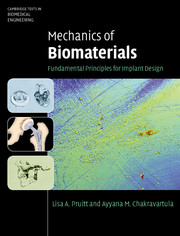Book contents
- Frontmatter
- Contents
- Symbols
- Prologue
- Part I Materials
- Part II Mechanics
- Part III Case studies
- 12 Regulatory affairs and testing
- 13 Orthopedics
- 14 Cardiovascular devices
- 15 Oral and maxillofacial devices
- 16 Soft tissue replacements
- Epilogue
- Appendix A Selected topics from mechanics of materials
- Appendix B Table of material properties of engineering biomaterials and tissues
- Appendix C Teaching methodologies in biomaterials
- Glossary
- Index
- References
12 - Regulatory affairs and testing
from Part III - Case studies
Published online by Cambridge University Press: 05 June 2012
- Frontmatter
- Contents
- Symbols
- Prologue
- Part I Materials
- Part II Mechanics
- Part III Case studies
- 12 Regulatory affairs and testing
- 13 Orthopedics
- 14 Cardiovascular devices
- 15 Oral and maxillofacial devices
- 16 Soft tissue replacements
- Epilogue
- Appendix A Selected topics from mechanics of materials
- Appendix B Table of material properties of engineering biomaterials and tissues
- Appendix C Teaching methodologies in biomaterials
- Glossary
- Index
- References
Summary
A medical device company is developing a material for use in vascular grafts. What should the designers keep in mind from a regulatory standpoint as they move toward developing a prototype implant?
The regulatory aspects of medical device approval can be the least familiar part of the medical device development process, particularly for engineers and scientists. It can be very useful to think ahead to what types of tests will be instrumental in gaining approval from the Food and Drug Administration (FDA). This company will want to decide if it is planning to market the device itself, or merely supply the material to another company that will be the primary distributor of the implant. Second, the company might want to check the FDA database to see what guidance the FDA may provide for these implants. Third, the company will need to determine whether a device made from this material is going to be entirely novel, or whether it can be classified as substantially equivalent to currently approved devices (perhaps the more simple path to market). Further details regarding medical device classification and the approval process will be given in this chapter.
Historical perspective and overview
The Food and Drug Administration (FDA) regulates $1 trillion in products per year, which includes 1.5 million medical devices (Chang, 2003; Swann, 2003). The Center for Devices and Radiological Health (CDRH) within the FDA is responsible for evaluating approximately 4000 new medical device applications each year, as well as monitoring the medical devices already offered on the U.S. market (FDA, 2010). With just over 1200 employees, the CDRH works daily to engage with industry members and physicians in defining the balance between safety, efficacy, and health benefits of medical devices. In addition to the large numbers, the devices approved and monitored by the FDA are also quite diverse, ranging from specialties such as neurology to gastroenterology; from implants as complex as the total artificial heart to items as simple as a bandage.
- Type
- Chapter
- Information
- Mechanics of BiomaterialsFundamental Principles for Implant Design, pp. 397 - 415Publisher: Cambridge University PressPrint publication year: 2011



